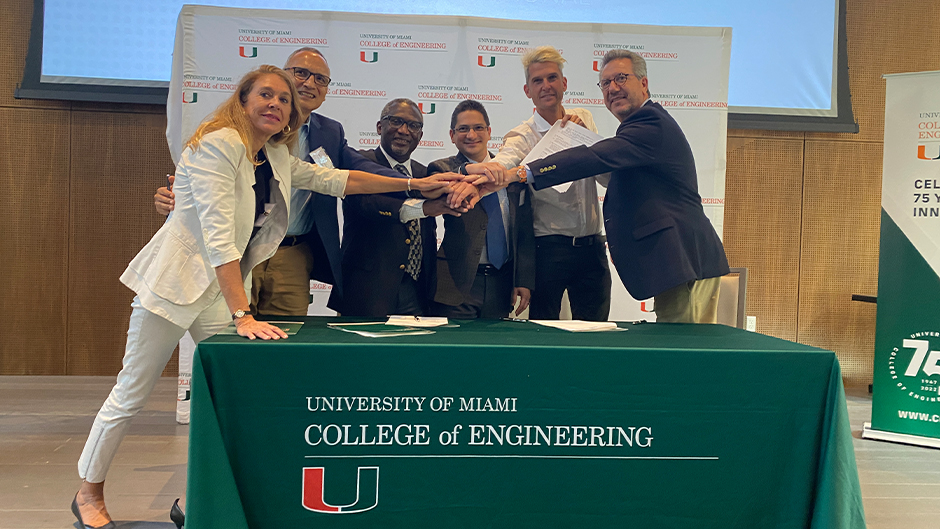At the Lakeside Auditorium on May 5, the College of Engineering hosted concrete industry heavyweights as they agreed to reach industry-wide carbon neutrality by 2050, among other ambitious goals.
“Concrete is the second-most used material in the world. Unless we change how this essential material is produced, net zero carbon emissions cannot happen,” says Dr. Antonio Nanni, chair of the Department of Civil and Architectural Engineering at the University of Miami College of Engineering and ACI Vice President. “I am extremely proud of how the University of Miami College of Engineering has enabled these historic agreements.”
Addressing the fact that cement production accounts for 7% of global carbon emissions, the Interamerican Cement Federation (FICEM) signed unprecedented agreements with the American Concrete Institute (ACI), ASTM International, and the Global Cement and Concrete Association (GCCA), focused on reducing industry-wide emissions and reaching carbon neutrality. FICEM, the major trade association of cement manufacturers, will join GCCA as an accelerator in the United Nations Race to Zero campaign to achieve carbon neutrality by 2050. ASTM International will build an alliance with FICEM to promote and standardize low-carbon cement. The day saw many substantive strides toward carbon neutrality.
Headquartered in Farmington Hills, Michigan, ACI is a leading global authority for the development, dissemination, and adoption of its consensus-based standards, technical resources, and educational, training, & certification programs. Founded in 1904, ACI has over 94 chapters, 244 student chapters, and 30,000 members spanning over 120 countries.
“The Institute is eager to expand this partnership with FICEM and we look forward to members of both organizations carrying on technical exchange and collaboration through committee activities, development of education products, and more,” said Charles K. Nmai, President, ACI. “This agreement aligns with ACI’s strategic goal to provide resources for concrete professionals globally and to effectively meet the demands of a changing world.”
“FICEM is very pleased to reinforce and expand our partnership with the American Concrete Institute through this updated International Partner Agreement,” said Maria Jose Garcia, Executive Director, FICEM. “This agreement reaffirms FICEM’s role in promoting the sustainable development of cement-based construction systems and highlights both organizations’ commitment to achieving a carbon neutral industry.”
FICEM represents over 25 of the largest cement producing companies, institutes, and associations in Latin America, the Caribbean, Spain, and Portugal. The organization promotes climate protection, energy efficiency, the use of alternative fuels and raw materials, as well as socially-beneficial applications of cement and concrete–housing, pavements, and infrastructure, among others.
FICEM and ACI’s joint efforts will be executed through the ACI Center of Excellence for Carbon Neutral Concrete (NEU). Providing technological access and knowledge needed to safely produce and place carbon neutral concrete, NEU encourages further industry cooperation through events, partnerships, research, technology acceleration, technical committees, and other related activities.
ASTM International has set over 12,000 global standards, enhancing performance and confidence in commerce and the lives of everyday people. ASTM standards, developed and implemented across the world, improve safety and reliability of structures and products, benefiting all sectors of society. ASTM President, Kathie Morgan, noted that “Cement and concrete standards have had a significant global footprint in ASTM for over a century. We stand ready to support the industry’s goals by leveraging our resources, including our new Xcellerate program to shorten the gap between research and standards, accelerating technology transfer to the market.”

President of the University of Miami Julio Frenk, Executive Vice President for Academic Affairs & Provost Jeffrey Duerk, and Dean of the College of Engineering Pratim Biswas joined the executive teams of each organization–including FICEM President Jose Raul Gonzalez, ACI President Charles Nmai, and COP27 High-Level Climate Action Champion Harald Friedl. After the signing of these agreements, Dr. Nanni led a fireside chat with attendees focused on overcoming the strategic challenges facing carbon neutrality in the concrete industry and how Latin American plays a leading role in achieving industry-wide change in concrete and cement.
Speaking on the importance of emerging technologies, César Constantino, Chair of the Board of ASTM, expressed how new, forward-thinking standards and revisions to existing standards embrace emergent materials, research, and climate-friendly goals. Harald Friedl spoke at length on how the concrete industry’s action on climate change can improve public trust, propelling innovators to tackle climate-related challenges. Jeffrey Duerk voiced his support for this crucial collaboration between industry and academia, citing the importance of ambitious goal-setting in achieving historic milestones.

